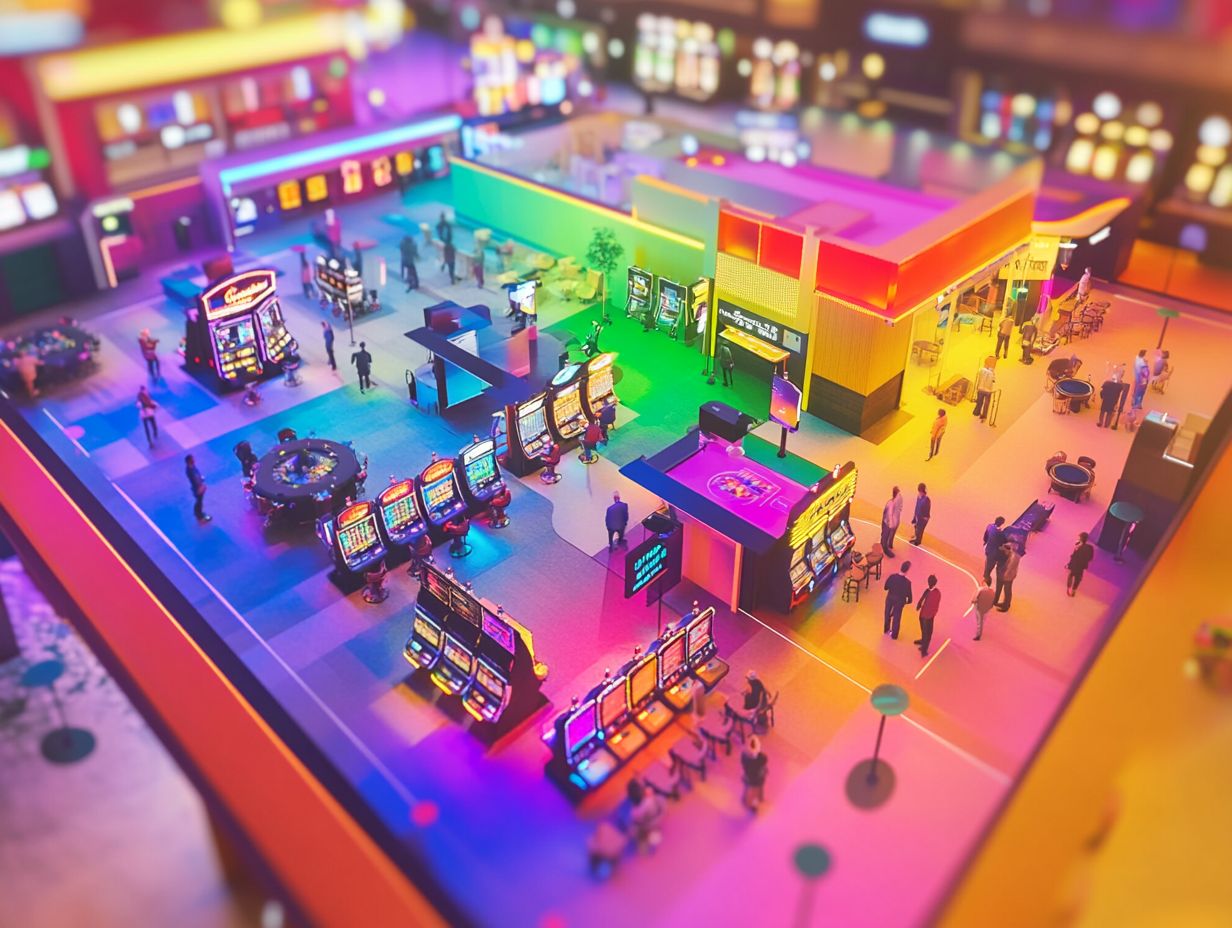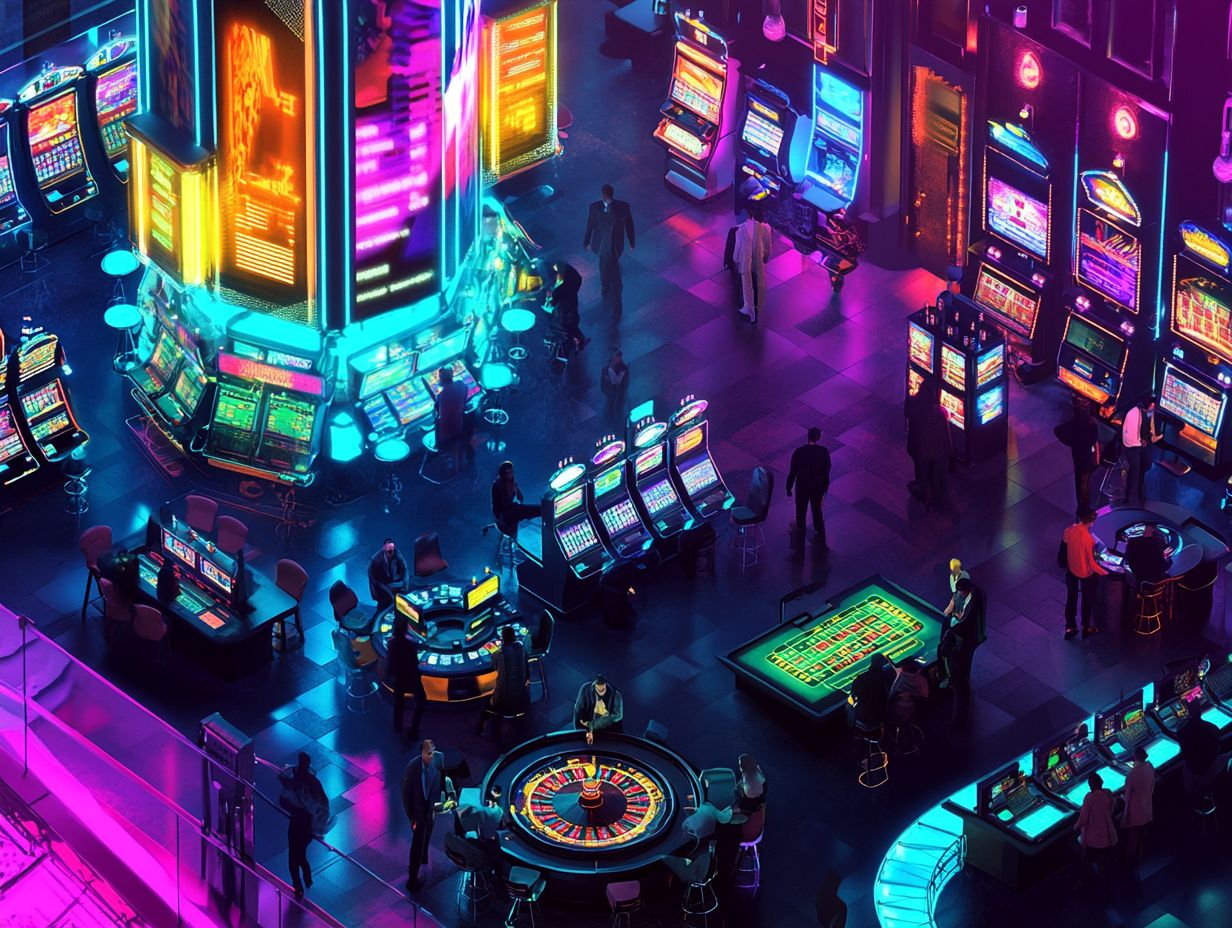The design and layout of a casino floor play a crucial role in shaping the visitor experience and driving revenue. From the strategic placement of games to the creation of inviting spaces, every detail matters. This article explores the significance of thoughtful casino design and how the collection and analysis of visitor data can enhance this process. We will uncover effective tools for data gathering, share best practices through case studies, and examine future trends in technology that promise to revolutionize casino layouts. Join us as we navigate this fascinating intersection of design and data.
The Importance of Casino Floor Layout and Design

The layout and design of a casino floor significantly impact the overall gaming experience for visitors, influencing everything from player engagement to gaming revenue generation. Visitor engagement can be increased by considering customer behavior and incorporating design strategies that enhance user experience.
A well-designed casino floor not only enhances the aesthetic appeal of the space but also effectively directs customer traffic patterns through foot traffic analysis and spatial analysis techniques.
Thoughtfully arranged casino floors enable customers to navigate seamlessly between gaming areas, social interaction zones, and service areas, improving both the traffic flow and overall visitor satisfaction.
By employing design strategies such as seat layout and slot machine placement, casinos can greatly enhance visitor satisfaction and loyalty, ultimately resulting in higher customer retention and reduced operational costs.
Impact on Visitor Experience and Revenue: Enhancing Casino Design through Visitor Data
The layout of a casino floor can significantly impact the visitor experience, directly influencing revenue generation and customer satisfaction. By analyzing visitor data, such as foot traffic patterns and player behavior, casino operators can adapt their layouts for layout optimization to enhance the overall gaming experience, increase player engagement, and boost gaming revenue.
Understanding Traffic Patterns: The Role of Design Strategy in Casino Layout
Recognizing traffic patterns is crucial for utilizing visitor data to improve casino layouts. By making layout changes that take foot traffic into account, casinos can enhance the performance of specific games through strategic game placement. Strategically placing high-traffic games can draw attention to particular areas, encouraging visitors to stay longer and increasing visitor patterns. This approach increases the likelihood of repeat visits to certain sections, ultimately raising revenue.
Heat Maps: Analyzing Visitor Patterns and Traffic Flow

Heat maps serve as an important tool for casino operators to understand how layout influences customer experience. These maps illustrate which areas of the floor experience heavy traffic and track player movement throughout the space. By utilizing heat maps, operators can adjust their layouts to optimize flow and reduce overcrowding.
Customer Journey Mapping and Demographic Trends
Mapping out customer journeys is another effective method for leveraging visitor data to improve the impact of layouts on customer experience and guide customer journey mapping. This technique allows casinos to visualize the steps players take from the moment they enter until they select a game. By identifying key moments along this journey, casinos can strategically place signage, advertising, or promotions to influence player decisions and enhance layout design.
Encouraging Interaction
Ultimately, a well-designed casino layout should promote interaction, minimize barriers, and consider accessibility considerations. An open and airy layout can help players feel more engaged, increasing their desire to stay longer. As customer needs evolve, casino layouts are rarely static; they will continue to adapt to meet those changing demands, ensuring design adaptability.
Collecting and Analyzing Visitor Data: Insights for Casino Layout Design

Casinos utilize the collection and analysis of visitor data to enhance their floor layout and design through data-driven design. By employing visitor data analytics, casinos can conduct foot traffic and demographic analyses, which helps them understand how customers are interacting with the space and identify areas for layout innovations.
This information allows them to identify areas that may require improvement and optimize design efficiency.
Tools and Techniques for Gathering Data: Enhancing Casino Design through Behavioral Insights
The following are some of the most important tools and techniques used to collect visitor data in casinos, all of which can aid in analyzing and making informed decisions about casino design.
- Data Analytics Platforms and Design Analytics: Advanced data analytics tools, such as SAS and R, enable casinos to collect transaction data, which can then be analyzed to identify gaming trends and behavioral insights. Behavioral analysis tools can also process streaming data from various sources, including players and the casino itself, guiding strategic planning.
- Machine Learning Applications and Design Strategy: Casinos can utilize machine learning applications to analyze collected data, allowing them to monitor and assess player flow, player retention, and preferences in real-time. The insights gained from this analysis assist casinos in making future design decisions that align with player needs and optimize gaming zones.
- Surveys: Surveys provide casino operators with a means to collect data directly from patrons, offering valuable insights into visitor experiences, customer satisfaction, and expectations regarding design principles. Depending on the specific needs of the casino, survey data can be gathered through self-administered questionnaires, interviews, or online surveys, contributing to design feedback.
- Heat Mapping Tools and Data Visualization: Heat maps visually represent collected data and are valuable for casinos seeking to understand foot traffic in different areas. They serve as important indicators of which sections of the casino are most popular and where engagement is highest, aiding in the development of interactive design and layout flexibility.
- Real-Time Data Tracking and Technology Integration: For casinos wishing to monitor usage as it happens, real-time data tracking tools are essential in analyzing operational efficiency. These tools collect data from both the casino’s own servers and third-party vendors. They have various applications, including monitoring player engagement in different areas of the casino. This real-time data can help casinos make immediate adjustments to the layout and design of the casino floor to maximize player engagement and enhance performance metrics.
Utilizing Visitor Data for Floor Layout and Design: Enhancing Casino Strategy
Using visitor data to inform floor layout and design is an effective strategy that enables casinos to create environments that resonate with players and encourage greater engagement. This aligns with casino strategy and enhances architectural design.
By analyzing collected visitor analytics, casinos can make informed decisions regarding the spatial arrangement of gaming areas, the effectiveness of signage, and the placement of comfort zones, optimizing them according to customer preferences and UX design principles.
This approach allows for a responsive design methodology that adapts to evolving trends, ultimately enhancing the overall user experience and satisfaction through experiential design.
Best Practices and Case Studies: Adopting Design Principles for the Gaming Industry

Implementing best practices in casino floor layout design has been shown to enhance visitor engagement and satisfaction, as demonstrated in various case studies. By utilizing advanced gaming technology and responsive design techniques, such as design adaptability and immersive design, casinos can create immersive experiences that cater to diverse player demographics.
These case studies indicate that layout changes, combined with customer feedback and design feedback loops, have led to improved operational efficiencies and increased gaming revenue.
Examples of effective practices in casino floor layout design highlight the significance of competitive analysis in the gaming industry. Understanding market trends and player preferences can inform marketing strategies that attract new customers and retain existing ones.
Successful casinos have employed customer retention techniques, such as loyalty programs and personalized gaming experiences, enhancing customer loyalty.
The integration of these factors maximizes player satisfaction and contributes to sustainable industry growth, illustrating that thoughtful design and responsive adaptation can yield significant long-term benefits and improve conversion rates.
Future Trends in Using Visitor Data for Casino Design: Embracing Design Trends and Innovations
The future trends in the casino industry regarding the use of visitor data for design are increasingly shaped by technological advancements and innovations in layout innovations.
Emerging technologies, such as augmented reality applications and advanced data analytics, are set to transform the casino experience by providing immersive interactions that closely align with player preferences and enhance user-centered design.
By embracing these trends, casinos will be better equipped to anticipate customer expectations and refine their operational layouts with business intelligence, ultimately ensuring maximum engagement and satisfaction in entertainment areas.
Technological Advancements and Potential Impact: Innovating Casino Features
Technological advancements are transforming the landscape of casino design by prioritizing user experience through data analytics and innovative technologies, enhancing customer attraction. These developments enable casinos to collect real-time data on player behavior, allowing them to make informed decisions regarding layout design and space allocation, improving design efficiency.
The impact of these technologies goes beyond aesthetics; they significantly enhance both the overall gaming experience and operational efficiency. By utilizing machine learning algorithms to analyze engagement metrics, casinos can optimize game placements and tailor marketing strategies by employing business intelligence, effectively attracting more players and encouraging longer visits.
Predictive modeling is also essential, as it allows establishments to forecast trends and proactively adjust their offerings through optimization techniques. This data-driven approach not only improves game design but also creates a more immersive atmosphere by customizing environments to meet the preferences of diverse audiences, enhancing sensory experience.
Ultimately, these advancements contribute to a richer and more dynamic gaming landscape that continually adapts to the evolving interests of players, improving the casino experience.






